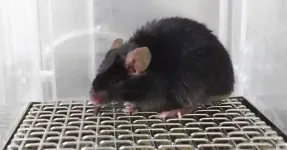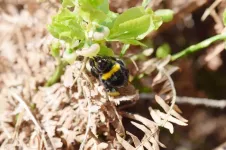(Press-News.org) Researchers at the RIKEN Center for Brain Science and the RIKEN BioResource Research Center in Japan, along with collaborators at the State University of New York at Buffalo, have created a mouse model that allows the study of naturally occurring melatonin. Published in the Journal of Pineal Research, these first experiments using the new mice showed that natural melatonin was linked to a pre-hibernation state that allows mice to slow down their metabolism and survive when food is scarce, or temperatures are cold.
Melatonin is called "the hormone of darkness" because it's released by the brain in the dark, which usually means at night. It tells the body when it's dark outside so that the body can switch to 'night mode'. Although other hormones are easily studied in the laboratory, it has been difficult to study how the body reacts to melatonin because laboratory mice don't actually have any. To solve this problem, the researchers crossed laboratory mice with wild mice--which do produce melatonin--and bred new lab mice that can produce melatonin innately. This was a lot harder than it sounds and took over 10 mouse generations.
Once they had melatonin-producing lab mice, the researchers were able to study how the hormone affects entrainment--the alignment of the body clock with the outside world. Mice like to run on wheels regularly, and researchers can use this to measure entrainment after suddenly changing the light/dark cycle, which mimics sudden changes in times zones. Compared with regular lab mice, the mice with innate melatonin adapted their wheel running times faster to darkness starting six hours earlier, similar to 'east-bound jet lag'.
The researchers were also able to resolve a debate about whether life span is affected by melatonin, which has been hard to study because of the missing melatonin in lab mice. "Now we finally have an answer: endogenous melatonin has no life-extending effects," says Takaoka Kasahara, a senior author of the new study.
Despite many similarities, mice with innate melatonin differed from regular lab mice in several ways. The regular lab mice were heavier, had bigger reproductive organs, and were more successful at mating, producing more pups. On the other hand, melatonin-producing female mice were able to enter a state called daily torpor, a kind of low-power mode similar to hibernation that can last for a few hours a day. Daily torpor is a way for mice to deal with food scarcity and cold temperatures by conserving energy.
"There is an evolutionary advantage to producing melatonin, because it protects wild mice from losing weight when they can't find enough food. Lab mice, however, are typically given unlimited food and live in warm cages," Kasahara observes. "Our finding that mice lacking melatonin are more successful at reproducing can explain why lab mice lack melatonin. Over the years, by selecting for mice that reproduce the most pups, we might have also been inadvertently selecting for mice with lower and lower levels of melatonin."
Having shown that melatonin can affect circadian rhythms, the specially bred melatonin-proficient mice will be valuable for studying the detailed molecular and neural mechanisms of melatonin signaling on the circadian clock and sleep, as well as the effects of melatonin on immunity and bone formation. These relationships have been suggested, but have not yet been closely examined.
Further research on melatonin's relationship with daily torpor and hibernation is also important. Melatonin is necessary for seasonal reproduction in several animals, signaling the length of the night, which indicates the season. "This research could very well lead to a better understanding of seasonal affective disorder, or winter depression, in humans," says Kasahara. "Indeed, one of the newest antidepressants, agomelatin, activates melatonin receptors."
The study was authored by the following researchers:
Chongyang Zhang, Shannon J. Clough, Ekue B. Adamah-Biassi, Michele H. Sveinsson, Anthony J Hutchinson, Ikuo Miura, tamio Furuse, Shigeharu Wakana, Yui K. Matsumoto, Kazuo Okanoya , Randall L. Hudson, Tadafumi Kato, Margarita L. Dubocovich , and Takaoki Kasahara
INFORMATION:
Reference:
Zhang et al. (2021) Impact of endogenous melatonin on rhythmic behaviors, reproduction, and survival revealed in melatonin-proficient C57BL/6J congenic mice. J Pineal Res. doi: 10.1111/jpi.12748.
How many tree species are there in the forest? How are the trees scattered throughout? How high are the individual tree crowns? Are there fallen trees or hollowed-out tree trunks? Forest scientists characterize forests according to structural factors. "Structural richness is very important for biodiversity in forests. But forests used for forestry are generally poor in terms of structure," says Tristan Eckerter from the Chair of Nature Conservation and Landscape Ecology at the University of Freiburg. Therefore, together with research teams from the Chair of Silviculture and the Black Forest National Park, he investigated ...
A new article published in the Journal of the Association for Consumer Research presents a neural model of maladaptive consumption.
Consumption (of, for instance, substances, food, and online media) is driven mainly by expected rewards that stem from the ability of the consumption act to satisfy intrinsic (e.g., curiosity) and extrinsic (e.g., job performance) needs. In the article, "A Triple-System Neural Model of Maladaptive Consumption," the authors define maladaptive consumption as a state of compulsive seeking and consumption of rewarding products or experiences, which are sustained despite the negative consequences of such behaviors.
"Understanding the neural basis of maladaptive ...
Pairing blueberry pie with a scoop of ice cream is a nice summer treat. Aside from being tasty, this combination might also help people take up more of the "superfruit's" nutrients, such as anthocyanins. Researchers reporting in ACS' Journal of Agricultural and Food Chemistry show that α-casein, a protein found in cow's milk, helped rats absorb more blueberry anthocyanins and their byproducts, boosting accessibility to these good-for-you nutrients.
In studies, anthocyanins have been shown to have antioxidant properties, lower blood pressure and reduce the risk of developing some cancers. However, only small amounts of these nutrients are absorbed ...
For patients who have inflammatory bowel syndrome (IBS), the condition is literally a pain in the gut. Chronic -- or long-term -- abdominal pain is common, and there are currently no effective treatment options for this debilitating symptom. In a new study in ACS Pharmacology & Translational Science, researchers identify a new potential source of relief: a molecule derived from spider venom. In experiments with mice, they found that one dose could stop symptoms associated with IBS pain.
The sensation of pain originates in electrical signals carried from the body to the brain by cells called ...
Air quality varies greatly within regions and cities around the world, and exposure to air pollution can have severe health impacts. In the U.S., people of color are disproportionately exposed to poor air quality. A cover story in Chemical & Engineering News, the weekly newsmagazine of the American Chemical Society, highlights how scientists and community activists are using new technologies to gather data that could help address this inequity.
Despite the success of the U.S. Clean Air Act in improving ambient air quality over the past 50 years, discriminatory housing, loan ...
Over recent years, the retina has established its position as one of the most promising biomarkers for the early diagnosis of Alzheimer's. Moving on from the debate as to the retina becoming thinner or thicker, researchers from the Universidad Complutense de Madrid and Hospital Clínico San Carlos are focusing their attention on the roughness of the ten retinal layers.
The study, published in Scientific Reports, "proves innovative" in three aspects according to José Manuel Ramírez, Director of the IIORC (Ramón Castroviejo Institute of Ophthalmologic Research) at the UCM. "This is the first study to propose studying the roughness of the retina and its ten constituent layers. They have devised a mathematical method to measure the degree of wrinkling, through the fractal ...
Children with obstructive sleep apnea are nearly three times more likely to develop high blood pressure when they become teenagers than children who never experience sleep apnea, according to a new study funded by the National Heart, Lung, and Blood Institute (NHLBI), part of the National Institutes of Health. However, children whose sleep apnea improves as they grow into adolescence do not show an increased chance of having high blood pressure, which is a major risk factor for heart disease.
The long-term study, one of the largest of its kind in the pediatric population, underscores the seriousness of sleep apnea in children and the importance of early treatment, the researchers said. Their findings appear online in the journal JAMA Cardiology.
Obstructive sleep apnea, ...
Previous research was falsely reassuring; captured only 2% of cirrhosis patients
Findings underscore lack of access to health care for Black patients
Cirrhosis is leading cause of death and affects more than 600,000 people in U.S.
CHICAGO --- Black patients with cirrhosis - late-stage liver disease - are about 25% more likely to die compared to non-Hispanic white patients and four times less likely to receive a liver transplant, reports a new Northwestern Medicine study.
Estimates of racial disparity in cirrhosis have been limited by a lack of large-scale longitudinal data, which track patients from diagnosis to death and/or transplant.
The paper is one of the first to link all seven large liver centers in Chicago with the death registry and transplant registry to examine ...
Psycholinguists from the HSE Center for Language and Brain, in collaboration with researchers from the City University of New York and the University of Stuttgart, investigated how reading in Russian varies among different groups of readers. The authors used a novel method in bilingualism research -comparison of the eye-movement sequences (scanpaths) in adult native speakers of Russian, Russian-speaking children, and adult bilinguals with different levels of Russian proficiency. The results of the study were published in Reading Research Quarterly.
A total of 120 readers took part in the study, with 30 participants in each group. Participants included adult ...
BUFFALO, N.Y. -- The giant plumose anemone is an animal, but it looks a bit like an underwater cauliflower. Its body consists of a stalk-like column that attaches to rocks and other surfaces on one end, and to a crown of tentacles on the other.
The anemones use these feelers to collect and shove food into their mouths, and a new study provides an in-depth look into the rich diversity of prey the anemones are catching. This includes a surprising menu item: ants, specifically the pale-legged field ant, Lasius pallitarsis. And the occasional spider.
The research was published on June 15 in the journal Environmental DNA. The study focused on giant plumose ...



